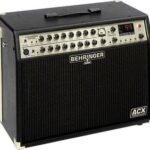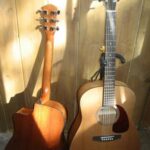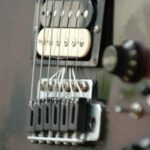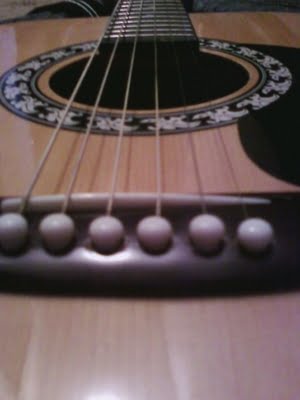Few things feel as good to a guitar playing parent or grandparent than having a child/grandchild express interest in learning how to play one. Two issues emerge immediately. The first, not addressed in any detail here, is whether or not that particular adult is the right person to teach the child how to play. The second immediate issue, that to which this article is addressed, is about choosing the best instrument for the child’s first learning and actual playing experience. A child’s first guitar. What should it be?
Often, the guitar playing adult wonders if a guitar built to accommodate to the body and hands of a much smaller person might due as a ‘throw-it-up-in-the-overhead-compartment’ travel guitar for yourself. The answer is ‘certainly.’ But, as with making any important purchase, there are a wide range of choices available and some important considerations to take into account.
The qualities of a good child’s guitar and of a good traveling guitar have a lot of things in common. They should be small enough to travel easily, be played by small hands and, above all, sound good.
There are essentially three ‘families’ of small acoustic guitars available and marketed to the ‘child’ and ‘travel guitar’ markets. The first group and the least expensive are actually toys and not really musical instruments at all. These are to be avoided unless they are being purchased as non-playing props in a photograph or play.
The best example I have personally experienced of this very bad idea is actually produced by an otherwise reputable guitar manufacturer, Dean. It is a ¾ size six-string called the Playmate JT. It looks like a small real guitar but is not actually adequately tunable enough to play correctly. Made entirely of inexpensive laminate materials and over-glossed, the frets are out of line and it is what you get (and all you should expect) for $35 – $50 in the unrealistic hope of finding a playable guitar of any size at all at that price. It is simply not playable by either a curious child or an experienced adult.
Nothing will exhaust the initial interest in learning to play an instrument than being given one to use that does not and cannot sound right – no matter what you do. This ‘toy’ and it’s counterparts: Washburn’s “Hanna Montana,” BeBoP’s “3/4 size Acoustic Guitar,” the Valencia CG-150K and the Discovery FG series by First Act are good examples of similar toys which may be fun for a small child to hold and posture with, but if learning to make music is the agenda, they are a waste of both your money and a will likely produce an undermining of the child’s initial interest in learning to play.
These toys are useless both as instruments to teach a child on and as traveling companions to a person who wants a guitar that can really be played and enjoyed. For the price, a decent dinner is a far better investment!
At the other extreme, there is the second group. These are the carefully crafted and beautifully made and musically superior small “Parlor Guitars” produced by many of the major acoustic guitar manufacturers and small volume master luthiers (guitar builders.) Called “Parlor Guitars” or 00-000 sizes by other manufacturers, these instruments are small enough to be held and played by a 6-7 year old child. But the cost is high. A Parlor size Martin, Gibson or Larrivee, for example, can run, easily, into the thousands of dollars. Because the interests of young children are sometimes fleeting, this would be a pretty serious investment in what might turn out to be a passing interest.
So – What’s in the middle? What acoustic guitars are 1) small enough to be held and played with relative ease by the small hands and incompletely developed musculature of a child, 2) well enough made to produce reliable, on key, sounds that can be satisfactorily played along with other instruments, and 3) substantial and musically true enough to double as traveling guitars for adults on the road or in the air?
There are at least two good current examples of the guitars that are found in this third group. Today, the two best bets are probably 1) the Little Martin model LX series which list from $279. and up depending upon the nature of the wood or laminate used for the top and whether or not it has the built-in capacity to be amplified, and 2) the Baby Taylor – the guitar that the Little Martin was developed to compete with. The Baby Taylor lists at $399, but retails for about $100 less than that. The Baby Taylor is topped with solid spruce. The ‘price points’ for both instruments are close enough so that the choice can be made entirely on the basis of sound, feel and preference – as it should be!
Both of these guitars are ¾ size Dreadnoughts. Both have laminate backs and sides. All of the Baby Taylors have solid wood tops and the Little Martin is available either fully laminate or with natural wood tops. The differences can be heard by the sensitive and/or trained ear. The outcome sound is a matter of personal preference. Both are well engineered, tune correctly, have properly aligned and easily playable frets and sound quite nice – nice enough to do a good job of accompanying an adult guitar player on a trip where space is limited.
Neither has the full sound, of course, of a full size Dreadnought – not should it be expected to. After all, the sound a guitar makes is a function of three variables. These are 1) its construction, 2) the strings and, of course, 3) the player. A smaller body makes a smaller sound. The laminate components are sometimes ‘dissed’ by guitarists as being akin to linoleum. Hooey! They produce perfectly adequate sound and are less damageable by extremes of pressure or temperature than is natural wood.
The Baby Taylor and Little Martin each have their own distinctive sound that is consistent with the expected heritage of each brand and the preferences of the players who choose them. The Little Martin has that brand’s characteristic mellow warmth, while the Taylor has that maker’s expected brighter sound – one more audible and able to ‘carry its own’ when played together with other instruments. Choosing the one with the ‘voice’ you prefer is a key aspect in selection. Also, as with buying any guitar, remember that each and every one is an individual with its own sound. When you think you have decided, play at least several of them to find the one that feels and sounds best to you.
Neither the Taylor nor the Martin is apt to disappoint the child who wants to learn and enjoy the sound s/he learns to make on it or the experienced adult guitar-playing traveler.
I am neither naïve nor wealthy and understand that spending somewhere between $280 – $380 on a small guitar is, in and of itself, an investment not everyone can afford. However, if you hope to give a child a satisfying and reinforcing experience learning to play a guitar, put a real one in their hands, not one of the toys.
I have not written specific reviews of either of these small guitars yet, but may do so in the near future. In the meantime, for some further tips about things to look for in an acoustic guitar, you may find it helpful to look over my reviews of some full-size ones including the Martin HD28, Blueridge BR180, the Simon and Patrick Vintage Burst, Walden’s G570 and the Taylor 355 (12-string.) An article about trying and choosing an acoustic guitar of any type that may also be of value can be found here. The information pertains to the selection of any guitar, including ones for children and/or for travel.
Make a good choice for yourself and for the child who wants to learn. I don’t think you can go wrong with either the Baby Taylor or the Little Martin. If you go for the cheap – cheap is what you will get. If the primary purpose is for your own enjoyment and you can afford it, consider a good Martin, Guild or Larrivee Parlor model guitar. They are small, but quite expensive and not really for the kids.





